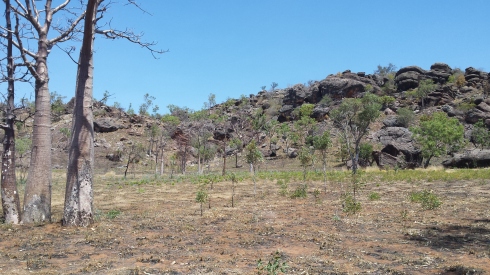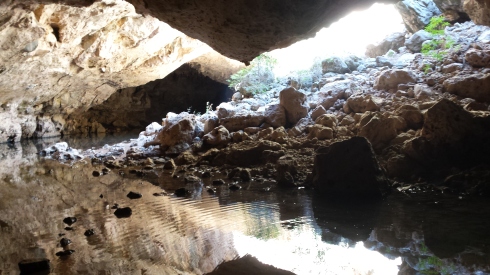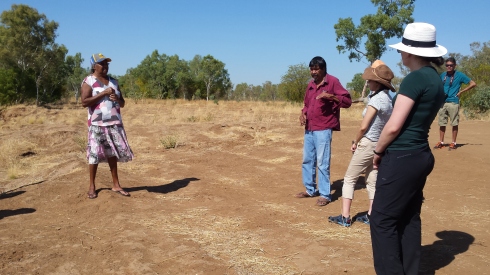From 10 to 14 September 2018 I was privileged to participate in the professional development course Introduction to Repatriation: Principles, Practice and Policies, convened by the National Centre for Indigenous Studies (NCIS) at The Australian National University in collaboration with the Kimberley Aboriginal Law and Culture Centre (KALACC) and Return, Reconcile, Renew project partners. The course was held in Broome, on the traditional country of Yawuru people, and in Fitzroy Crossing, on the traditional country of Bunuba people.

KALACC head office, Fitzroy Crossing. Photo: Hilary Howes.
Although my current postdoctoral research does not focus primarily on repatriation, there are significant overlaps; many of the German-speakers who contributed to the early development of archaeological theory and practice in the Pacific region were responsible for removing ancestral remains from Australia and the Pacific Islands. The German ornithologist and ethnologist Otto Finsch, who removed ancestral remains from Cape York, Torres Strait, New Zealand, and Hawai’i, falls into this category; so do the Polish-born traveller-naturalist Johann Stanislaus (Jan Stanislaw) Kubary, the Austrian anthropologist Rudolf Pöch, and the Swiss traveller-naturalist Fritz Sarasin, among others.
On Day 1 of the course, I contributed some reflections on German collecting institutions’ engagement to date with repatriation issues as part of a panel on “The rise of the repatriation movements: Indigenous achievement and changing museum ideology”. Other than that, I spent my time listening and learning. Presenters in Broome explained the significance of repatriation for healing, nation-building, and reconciliation; they also explored the historical context of the removal of ancestral remains, the motivations of those who took them, and Indigenous responses to what were predominantly acts of violence, theft, trickery or coercion.
In addition, we were shown the 2007 documentary “Dark Science”, an examination of Swedish entomologist Eric Mjöberg’s expedition to the Kimberley region in 1910-11. Even Mjöberg’s fellow expedition members were shocked by his rapaciousness in acquiring ancestral remains. Following his return to Sweden, Mjöberg died impoverished and insane; Bunuba elders believe he suffered spiritual retribution for his impious acts. In 2004 the Swedish Museum of Ethnography returned ancestral remains taken by Mjöberg to their Traditional Owners.

Bunuba country. Photo: Hilary Howes.
During our time in Fitzroy Crossing, we were privileged to visit the rock shelter where these ancestral remains had been returned to country. Bunuba elder Dillon Andrews conducted a smoking ceremony and invited us to leave our handprints in yellow ochre on the wall of the rock shelter – a gesture of extraordinary generosity and trust. Dillon and his colleagues Claude and Emmanuel then accompanied us to Tunnel Creek, the hideout of Bunuba resistance fighter Jandamarra, who held white settlers at bay for almost three years. His extraordinary story, recounted to us by Dillon and danced by Emmanuel in the atmospheric setting of Tunnel Creek, is also told in the award-winning book Jandamarra and the Bunuba Resistance. When Jandamarra was eventually cornered and killed in 1897, his head was hacked off as a trophy and his skull subsequently sent to an arms manufacturer in Birmingham, U.K. Efforts to locate it are ongoing.

Tunnel Creek. Photo: Hilary Howes.
Accompanied by KALACC Repatriation Officer Neil Carter, who is doing extremely important and difficult work on limited and precarious funding, we also visited the old and new Fitzroy Crossing cemeteries. The old cemetery was located on the banks of the mighty Fitzroy River. It was deceptively peaceful when we saw it, but in flood the water can rise to chest height above the ten-metre banks, and Fitzroy Crossing becomes an island, cut off from the outside world for up to four months at a time.

Bunuba elder Mary Aiken and KALACC Repatriation Officer Neil Carter with course participants at the old Fitzroy Crossing cemetery. Photo: Hilary Howes.
Neil and Bunuba elder Mary Aiken explained that flooding in 2017 had eroded the soil and exposed remains, leaving body bags hanging from the bank and washing skulls downstream where they were found by children playing in the water. Local authorities had foreseen this risk years ago and had exhumed the remains of European pioneers, relocating them to a neatly fenced-off area in the new cemetery, but left the Aboriginal remains in place. After the 2017 floods, KALACC and Bunuba elders worked tirelessly to have those remains not yet washed downstream exhumed and moved to higher ground. Historical documentation helped identify a few of those exhumed, and an archaeologist has been contracted to undertake DNA testing in the hope of identifying others.

New Fitzroy Crossing cemetery. European graves in foreground, recently reburied Aboriginal remains in background. Photo: Hilary Howes.
This week was an invaluable opportunity to learn on country from Indigenous and non-Indigenous repatriation experts. I am deeply grateful to all those who gave generously of their time and expertise to make it possible, especially Neil Carter and his KALACC colleagues, NCIS Deputy Director Cressida Fforde, and the Return, Reconcile, Renew project and its partners.

Such a wonderful experience to have shared with you Hilary and thank you for your amazing contributions to the week.
LikeLiked by 1 person
Thank you for writing this Hilary! It was so great to meet you and to talk over one another in our happiness.
LikeLiked by 1 person